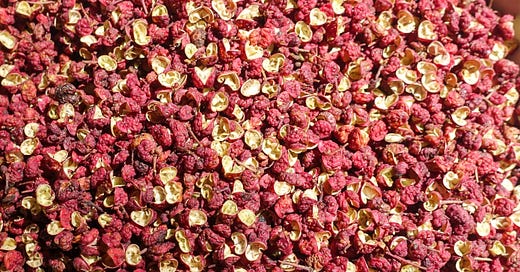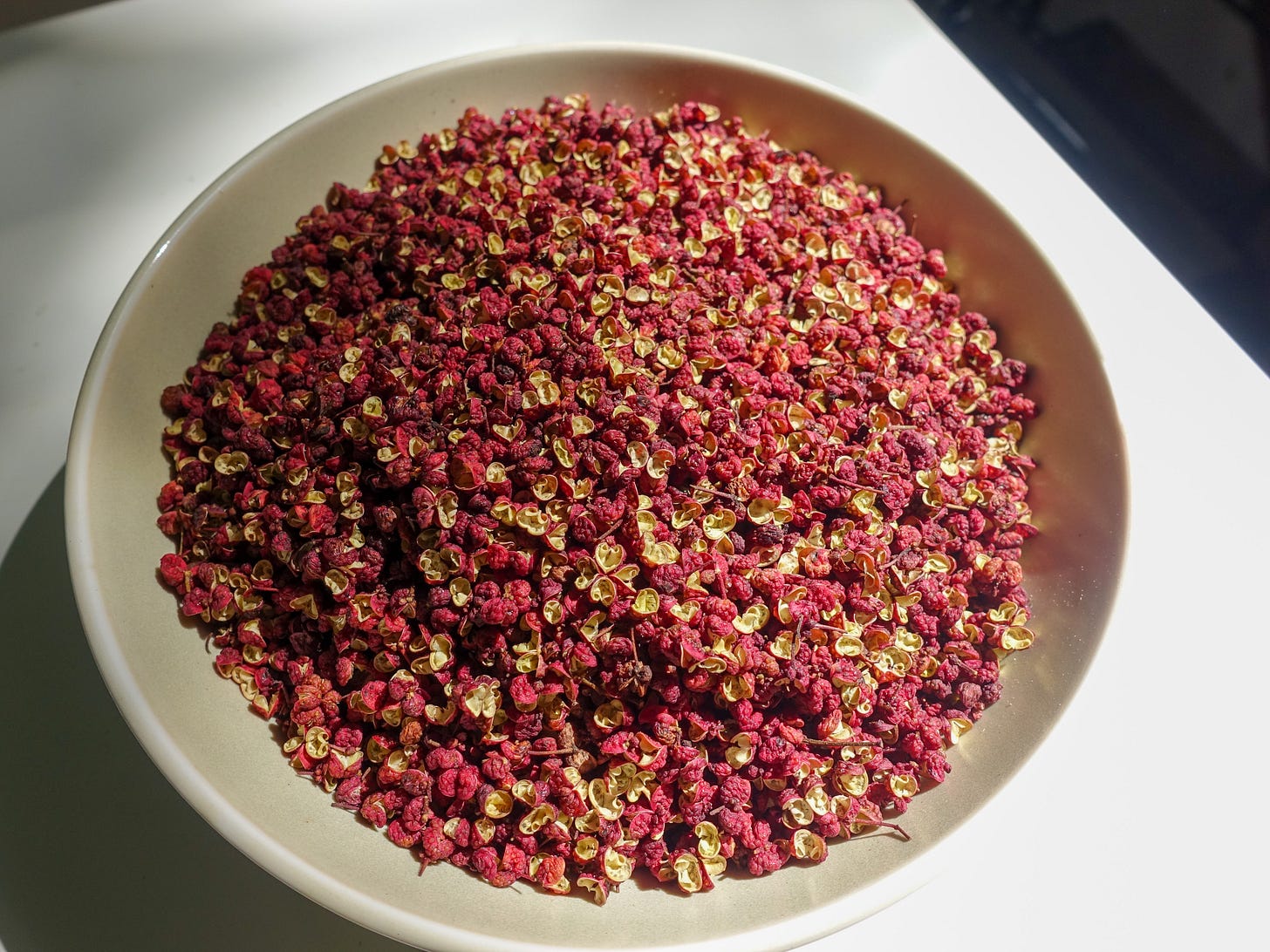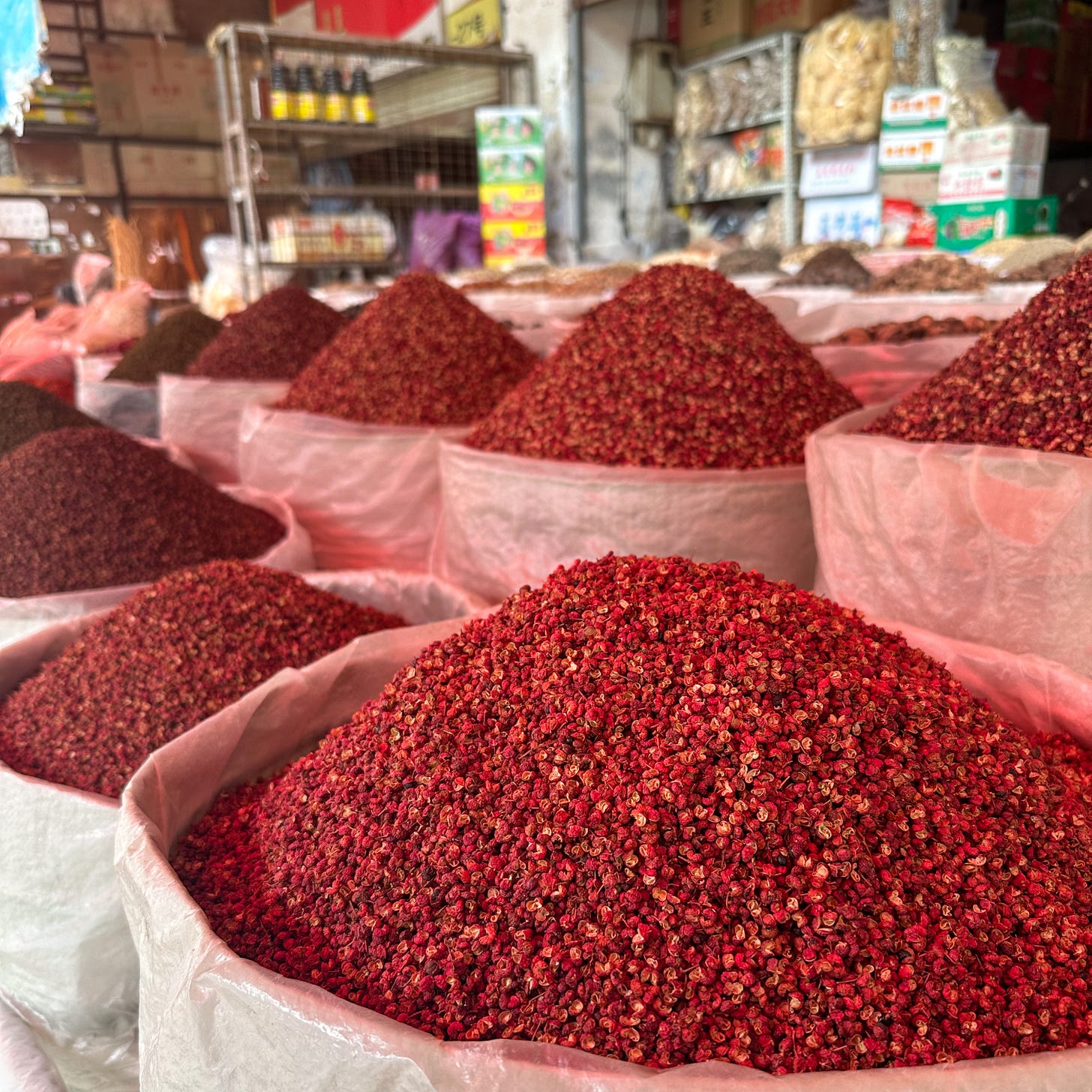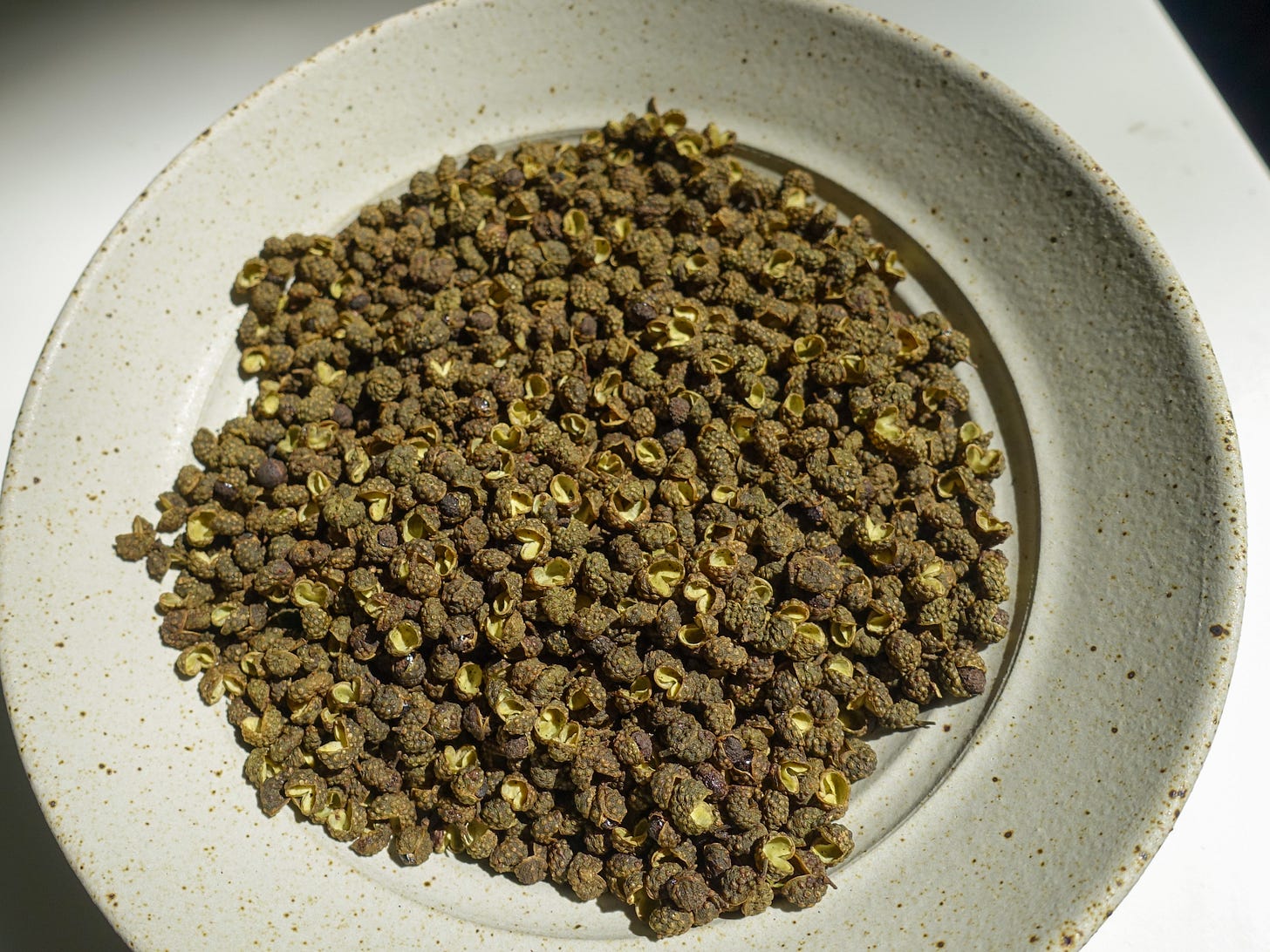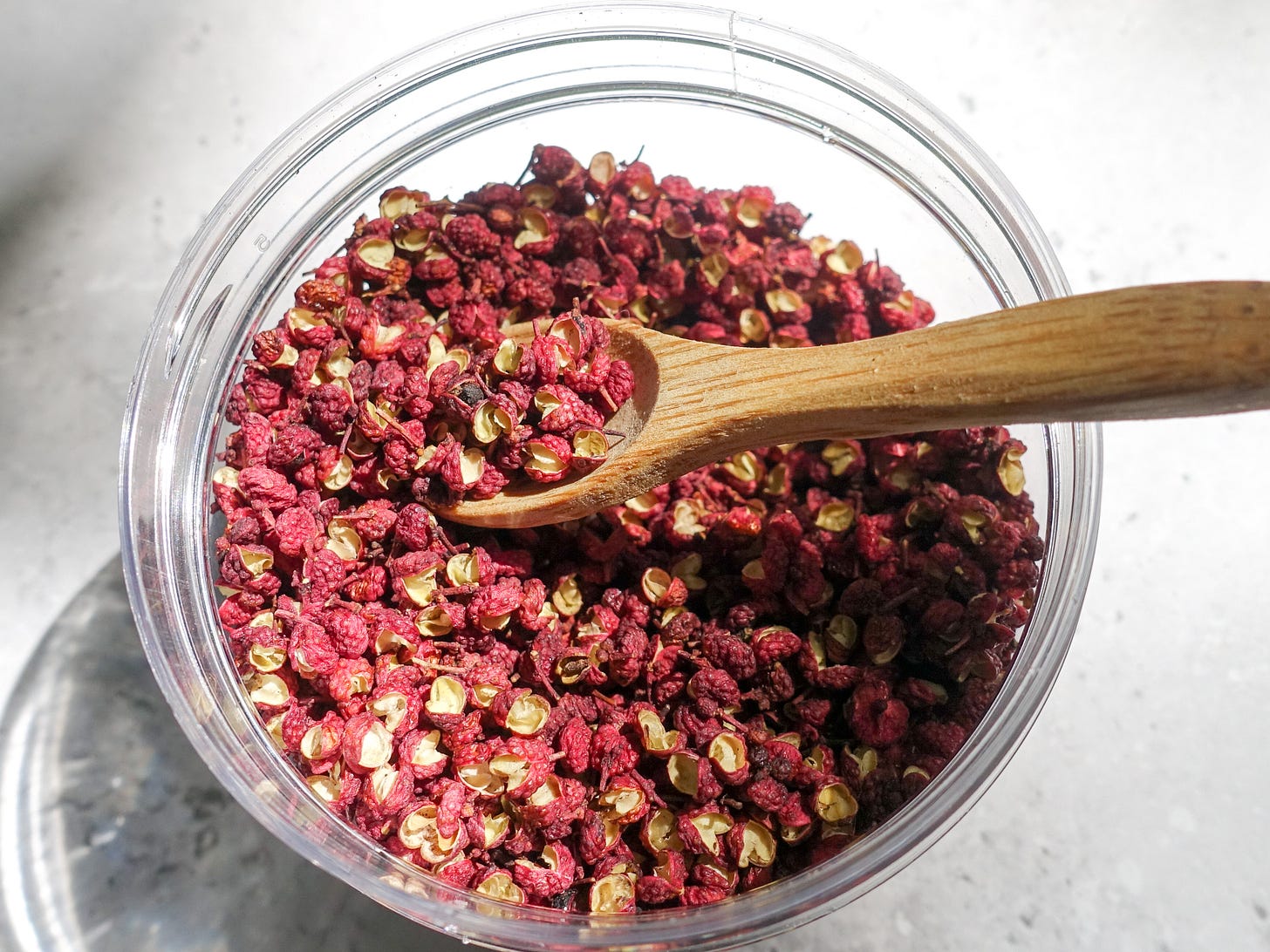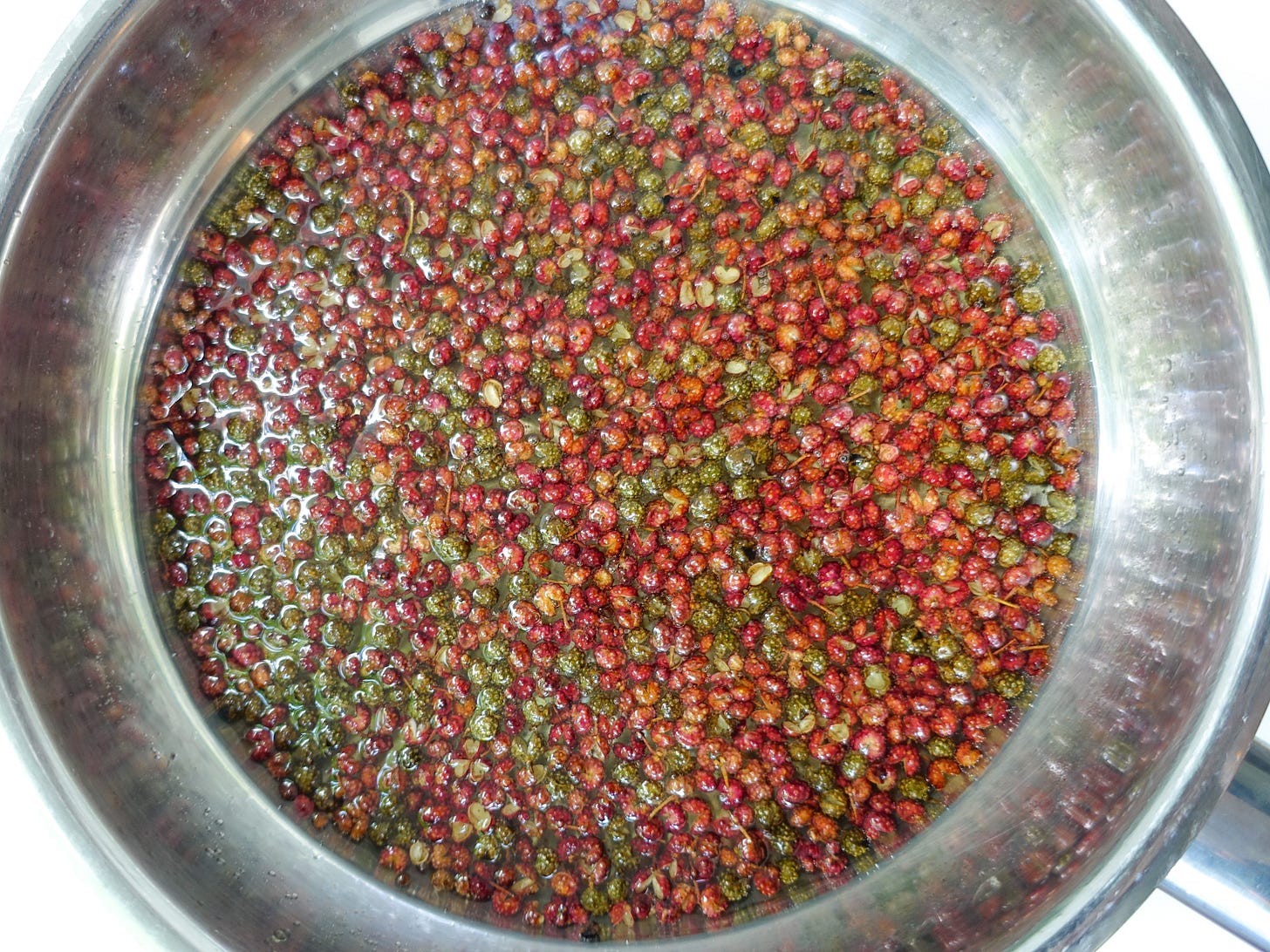Hi, this week is another Chinese pantry talk! We’re talking about a spice that’s unique and ubiquitous in Chinese and Sichuan cuisine, both captivating and daunting to those who’re not familiar: the magical Sichuan pepper. You can find my digestible video here.
What are Sichuan peppers?
Sichuan peppercorns (huajiao, 花椒) are an ancient and quintessential ingredient in Chinese cuisine, cherished across the nation but especially prominent in Sichuan Cuisine. These berries are hand-picked from mountainous prickly ash trees, then carefully dried and processed into whole, ground, or oil forms. The dried peppercorns, resembling miniature florets with open dark red husks and small bumps, exude a refreshing citrusy aroma and impart a warm, punchy, and mouth-numbing taste1. They are used to enhance aroma, cut through fat, and eliminate any meaty or fishy flavors. While they are commonly seen lavishly scattered atop dishes like mapo tofu or water-boiled beef, you can also find them in meat preservation with salt or hidden in sauces for noodles and pastries.
In Sichuan cuisine, they’re essential in flavor profiles like Mala (spicy and numbing), Guaiwei (strange-flavor), and jiaoma (numbing and aromatic). It can be an acquired taste; those who bite into one unexpectedly might feel their lips oddly sedated. However, this is a magically transformative ingredient loved by street food cooks as well as fine dining chefs. I’ve had a whole meal dedicated to Sichuan pepper in a fine dining restaurant in Chengdu where they appeared in ice cream and macarons
Sichuan pepper is a plant that is native to China and has been used for both medicinal and culinary purposes for thousands of years. It was used long before chili peppers were introduced to China, and the duo have since become the most iconic flavors of Sichuan Cuisine.
Red vs. green Sichuan peppers
There are two main types of Sichuan pepper: red and green.
The red Sichuan pepper is the most common and widely used variety across China, known for its earthy, aromatic flavor. When a recipe specifies Sichuan pepper, it typically refers to the red variety.
The green variety (qinghuajiao 青花椒) is less common and has a distinct floral and lime-like fragrance, and a more pronounced numbing taste. It’s often referred to as "numbing pepper" (majiao, 麻椒) in Sichuan. Green peppercorns are frequently used whole, alongside red ones, in dishes like hotpot or spicy Jianghu braised dishes to impart an extra tingling sensation. Additionally, in Sichuan, you may encounter a smaller green variety known as Tengjiao (藤椒) or rattan pepper, primarily enjoyed fresh or processed into oil.
I would recommend starting with red and slowly advancing to green pepper and using only sparingly. Some chefs suggest using "red Sichuan pepper for red meat (pork, beef) and green for white meat (fish, chicken)." Green Sichuan pepper can be used together for dishes like water-boiled fish (shuizhuyu) and stir-fried chicken with fresh chilis (jianjiaoji 尖椒鸡).
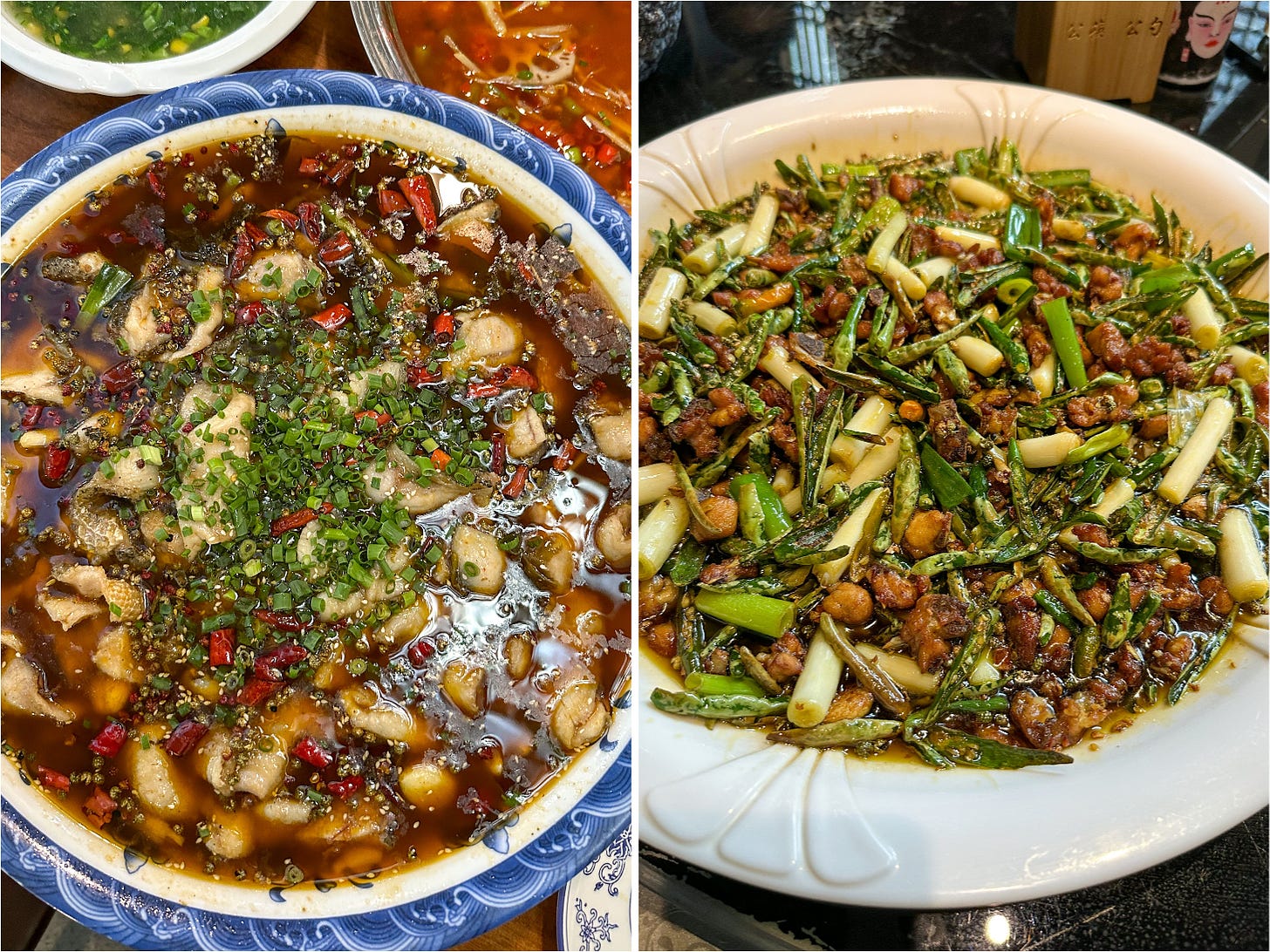
How to Use Sichuan Peppers
Fresh Sichuan pepper are used in Sichuan when in season. Here in Asian grocery store, you will find three Sichuan pepper products: whole peppercorns, ground Sichuan pepper and Sichuan pepper oil.
Whole Sichuan peppercorns
Use in: Mapo tofu, Crispy fried pork (Su rou), Kung Pao Chicken, Soy-vinegar pickles
Whole Sichuan peppers are incredibly versatile in cooking, used in both warm and cold dishes. In stir-fry dishes, Sichuan peppers are "bloomed" in hot oil along with chili peppers to release their aroma, a technique known as "qiang chao" (呛炒). They're also incorporated into stews or soups alongside spices like star anise and cinnamon, or added to marinades to remove meaty or fishy flavors. Additionally, they find their way into Sichuan lactose-fermented pickles and dumpling fillings, typically after being soaked in water and using the infused water My grandma always throws a few kernels of Sichuan pepper in the rice container to deter rice weevils.
Ground Sichuan Pepper
Use in: Sweet-water noodles, Sichuan jelly noodles
Ground Sichuan pepper is the most potent way to use Sichuan pepper, where the full tingling potential is released. It's often used in cold appetizers, noodle dressing, dry dipping seasoning, and as a final touch for warm dishes. Jiao yan (ground Sichuan pepper, salt, optionally with other spices) is a popular seasoning to dip fried meat and vegetables. Be careful not to go too far with the dose; I often start with just a pinch or 1/8 tsp per portion.
Just like any spice or your coffee beans, store-bought ground Sichuan beans can lose their power after opening, so I normally make them from whole peppercorns.
To make fresh ground Sichuan pepper: toast whole Sichuan pepper in a dry pan over medium-low heat for 3-5 minutes until fragrant, tossing in-between, let cool then grind in a spice grinder or with mortar and pestle.
Why toast? Toasting is to release its aroma, as raw Sichuan pepper taste bitter and less fragrant. After toasting you can even see some oil released from the peppers. If you’re using whole peppercorns in cooking (in oil or broth), you don’t need to toast them.
Sichuan Pepper Oil
Use in: Smashed cucumber salad, Sichuan Zajiang noodles
Sichuan pepper oil is used to preserve freshly harvested pepper, but now it's a handy condiment for those who want a quick fix. It’s best used in cold appetizers or noodle dressing, but can also add a final touch to stir-fries as well. I like to add a drop when I’m frying cabbage for an extra kick of aroma.
You'd find red, green Sichuan pepper oil and tengjiao oil. I normally go for the brand Yaomazi(幺麻子). Store-bought oil is often more concentrated due to extraction techniques than homemade ones. You can also choose from red Sichuan pepper oil or tengjiao oil (with a stronger citrusy aroma). My go-to brand is Yaomazi. But if you don’t have access to it, you can make it yourself with this mini recipe.
Homemade Sichuan Pepper Oil: Mix 5g green Sichuan pepper and 15 red Sichuan pepper (You can use only red, too), soak in water for 5 minutes, then drain and dry completely. Heat 200g of oil to 150ºC, then turn off the heat. Add the Sichuan peppercorns and let fry in residual heat, stirring to prevent burning. Once it cools off, transfer to a container, let the peppercorns sit in the oil for 24 hours to let the flavor steep. Then sieve and transfer to an airtight jar or bottle.
How to choose the best Sichuan pepper
High-quality Sichuan pepper originates from a few specific regions, notably Hanyuan (汉源) and Maoxian (茂县) in Sichuan, Hancheng (韩城) in Shaanxi, and Wudu (武都) in Gansu. When purchasing Sichuan pepper, seek out these regions, ensuring a fresh production date (they’re usually harvested in late summer or autumn). Among these, Gong Jiao (贡椒), or tribute pepper from Hanyuan is the most premium and personal favorite. From a wholesale spice market in Chengdu, I learned from local vendors that pricing is primarily influenced by origin, quality, and annual yield.
Tips for choosing Sichuan pepper
Good Sichuan peppers are vibrant dark red or green (if they’re already brown and black, don’t buy it), with noticeable oil bumps on the husk. They should have minimal black seeds, ideally less than 5%. Additionally, the peppers should be properly dried, devoid of any signs of mold. When grabbed with hand, they should feel lightly prickly and emit a strong aroma, indicative of freshness. Stale Sichuan pepper lacks this distinct aroma.
How to store it?
To preserve their freshness, store Sichuan pepper in a dry, shaded location. Vacuum sealing is an effective method for long-term preservation if you’re not using it soon. In general, Sichuan pepper oil keeps best aroma after a longer time.
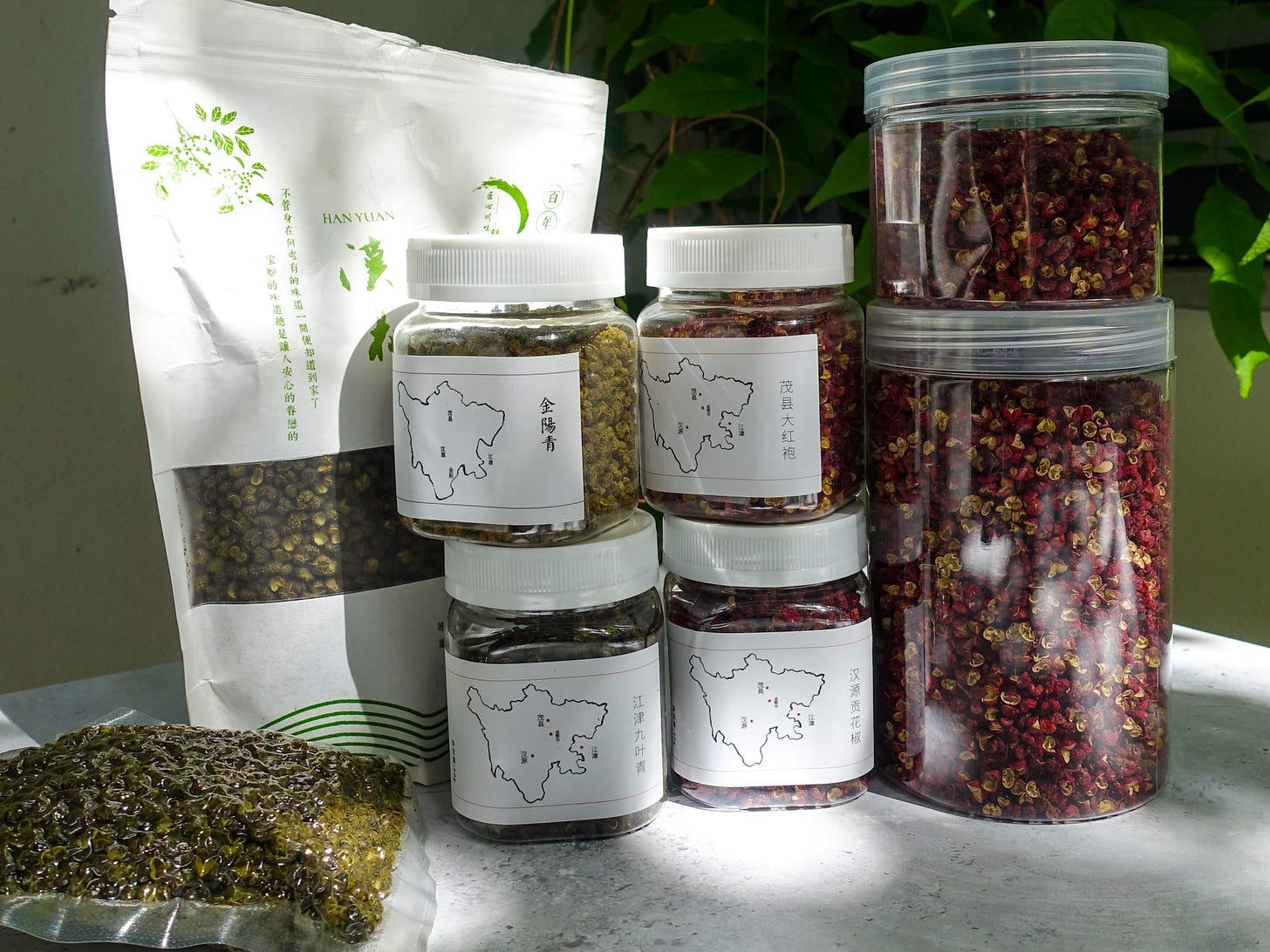
Where to buy?
Personally, I always bring some Hanyuan Sichuan pepper back to Berlin from my visits to Sichuan, as finding high-quality pepper locally in Germany has proven challenging, except for one Swedish shop that sells single-origin Sichuan pepper.However, well-stocked Asian supermarkets may offer Hanyuan Sichuan pepper or Dahongpao Sichuan pepper. In the US, consider providers such as Mala Market and 50 Hertz Food.
If you have more questions regarding Sichuan pepper, leave me a comment and let’s crack it together!

